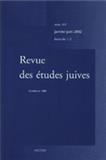- 投稿方式--Email投稿
-
期刊属性
-
- 中科分区:4区
- OA期刊:否
-
- 综述期刊:否
- TOP期刊:否
-
- 期均国文:0
- 环比增速:0%
-
期刊信息
- 研究方向:HUMANITIES, MULTIDISCIPLINARY
- 国际刊号:ISSN 0484-8616;EISSN 1783-175X
-
- 期刊语言:法语
- 出版地区:比利时
- 投稿网址:
- 电子邮箱:rejredaction@gmail.com (官网邮箱:文章(20201029更新)),jp.rothschild@irht.cnrs.fr (官网邮箱:书评(20201029更新))
- 期刊官网:https://poj.peeters-leuven.be/content.php?url=journal&journal_code=REJ
- 作者指南:
- 出版商网址:https://www.peeters-leuven.be/
- 出版地址:BONDGENOTENLAAN 153, LEUVEN, BELGIUM, B-3000
- 期刊简介:REVUE DES ETUDES JUIVES《犹太研究杂志》(半年刊)。Fondée en 1880, la Revue des Études Juives, unique dans sa spécialité en Europe, est publiée par la Société des Études Juives. La revue est consacrée à l’étude de tous les aspects du judaïsme à travers l’histoire selon les méthodes scientifiques. Elle publie des études relatives à la religion, à l’histoire, aux littératures et aux sociétés juives, et principalement en ce qu’elles concernent les juifs en France, ainsi que des travaux d’anthropologie.
-
万维提示
-
1、投稿方式:邮箱投稿。
2、期刊网址:
https://poj.peeters-leuven.be/content.php?url=journal&journal_code=REJ
3、官网邮箱:rejredaction@gmail.com(文章投稿)
jp.rothschild@irht.cnrs.fr(书评投稿)
4、期刊刊期:半年刊,一年出版两期。
2020年10月29日星期四
投稿须知
【官网信息】
Notes for contributors
Articles are considered for publication on the strict understanding that they have not previously been published nor are currently on offer to any other journal. Once accepted, articles shall not be published elsewhere in any language or in any form, printed or online.
They are submitted in English, French, German, Italian, or Spanish, in a standard electronic format. Non-native speakers are strongly encouraged to have their contribution corrected by a native speaker before submission. The submissions include two summaries of ca. 10 lines, the one in French and the other in whatever usual academic language.
Transliterations
Quotations in foreign languages whose length exceeds one line will be written in their specific alphabet (Hebrew, Greek, Arabic…). For shorter quotations or single words in Hebrew, make use of the following table: ʾ for א) not at the beginning of a word); b and bh for בּ and ב ;h for ה) not at the end of a word, unless with mapiq); w for ו ;ḥ for ח ;ṭ for ט ;k and kh for כּ and כ ; ʿ for ע ;p and ph for פּ and פ ;ṣ for צ ;q pour ק ;š for שׁ ;ś for שׂ .Do not transliterate long vocals and the dagešim ḥazaqim if you are not sure to be consistent in doing so.
Further rules (papers in English)
Single foreign words are in italics, quotations are put within quotation marks; use single quotation marks only in the case of a quotation within a quotation, not for single words.
Books of the Bible are not italicized: II Chronicles 9:2; Matthew 26:8.
References are given in full in the footnotes. Bibliographies at the end of the articles are not accepted. Do not use abbreviations in first or single references. Use initials for authors’ first names, small capitals for the surnames, a comma between the names of two authors or more.
Book titles are in italics; names of publishers and series titles are not included, e.g.:
L. GINZBERG, The Legends of the Jews, vol. 6, Philadelphia, 1968, p. 365, n. 67.
Articles in Journals: title of the article within double round (English) quotation marks (“…”), journal title in italics, volume number/part in volume (if any) in Arabic numerals, year within parentheses, including page numbers (linked by a short hyphen: 000-000, not 000–000) followed by specific page number within parentheses if necessary, e.g.: G. SERMONETA, “La dottrina dell’intelletto e la ‘fede filosofica’ di Jehudah e Immanuel Romano”, Studi Medievali, 3rd series, 6/2 (1965), p. 1-76 (48).
Articles in Books: as above, with the use of “in” between the title of the article and the reference of the book: L. I. LEVINE, “Archaeological Discoveries from Greco-Roman Era in Recent Archaeology in the Land of Israel”, in H. SHANKS, B. MAZAR (eds), Biblical Archaeological Society, Washington-Jerusalem, 1984, p. 75-96.
Repeated References: “ibid. ” is used only for a repeated reference immediately following the previous one; in other cases, use the author’s surname with either a short title or (only in non ambiguous cases) art. cit. for an article, op. cit. for a book, e.g.: SERMONETA, “La dottrina”, p. 17 / SERMONETA, art. cit., p. 17.
Use “Cf.” only for “Compare” and not instead of “See” (the latter, by the way, is in most cases useless).
Hebrew Titles: in most cases, in recent scholarly publications, the titles of the Hebrew books and articles are given in a European language (mostly in English), somewhere at the beginning or at the end of the Hebrew book: cite only this form, followed with “(Hebrew)” (within brackets), e. g.: J. DAN, On Gershom Scholem. Twelve Studies (Hebrew), Jerusalem,
2010. When such a translation does not exist, the Hebrew title will be given in transliteration, and followed by your own translation within square brackets, e. g.: G. SCHOLEM, “ʿIqbhotaw
šel Gabirol ba-qabala” [Traces of Ibn Gabirol in Kabbalah], in A. A. KABAK, E. STEINMANN (eds.), Meʾaseph sophre Ereṣ Yisraʾel, Tel-Aviv, 1940, p. 160-178. Well-known titles of classical works (e.g.: Mišneh Tora) do not require such a translation; by the same token, in an article intended for specialists in halakha, paršanut, or balšanut, etc., when quoting a host of ancient Hebrew books, even less well-known, you are not expected to (rather, you are expected not to) translate them.
- Contemporary Physics《当代物理学》
- Discrete Analysis《离散分析》
- Chemical Industry & Chemical Engineering Quarterly《化学工业与化学工程
- ARP Rheumatology《ARP风湿病学》(原:Acta Reumatologica Portuguesa)
- ZFW-Advances in Economic Geography《ZFW:经济地理学进展》(原:Zeitschrif
- Yale Journal of Biology and Medicine《耶鲁生物学与医学杂志》
- Turkish Journal of Zoology《土耳其动物学杂志》
- Turkish Journal of Veterinary & Animal Sciences《土耳其兽医与动物科学杂志
- The Turkish Journal of Pediatrics《土耳其儿科杂志》
- Turkish Journal of Medical Sciences《土耳其医学杂志》
- Reproductive Sciences《生殖科学》
- Rejuvenation Research《抗衰老研究》
- Die Radiologie《放射学》(原:Der Radiologe)
- Quarterly Reviews of Biophysics《生物物理学评论季刊》
- Psychiatry and Clinical Neurosciences《精神病学与临床神经科学》
- Preventive Veterinary Medicine《预防兽医学》
- Physics of Particles and Nuclei《粒子核物理学》
- Numerical Linear Algebra with Applications《数值线性代数及其应用》
- Nanoscale and Microscale Thermophysical Engineering《微/纳尺度热物理
- Matrix Biology《基质生物学》

